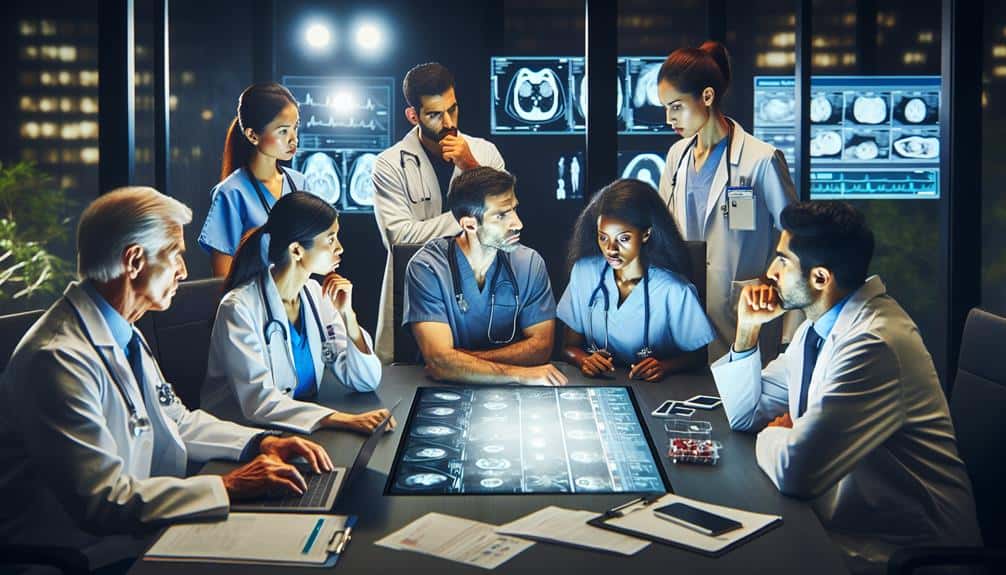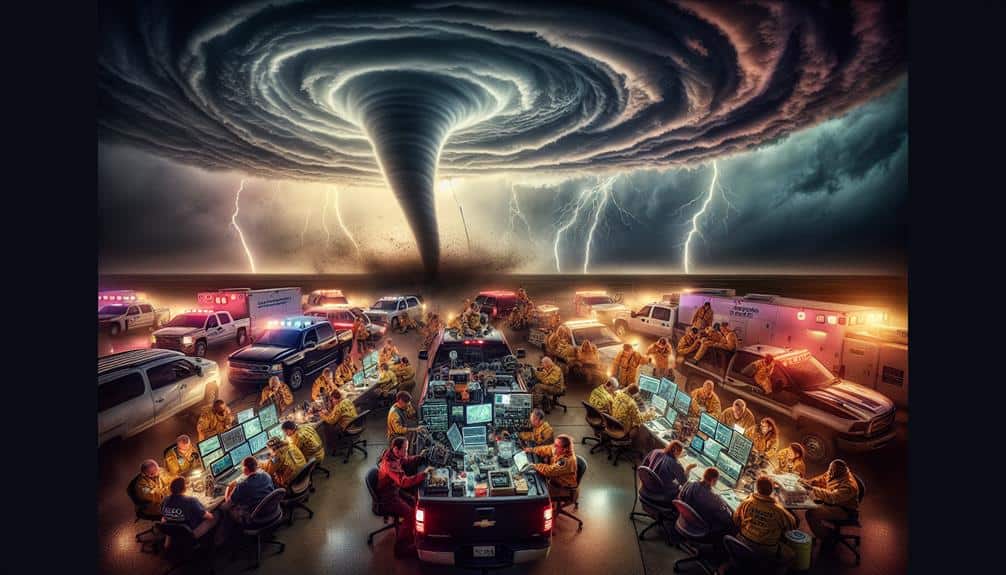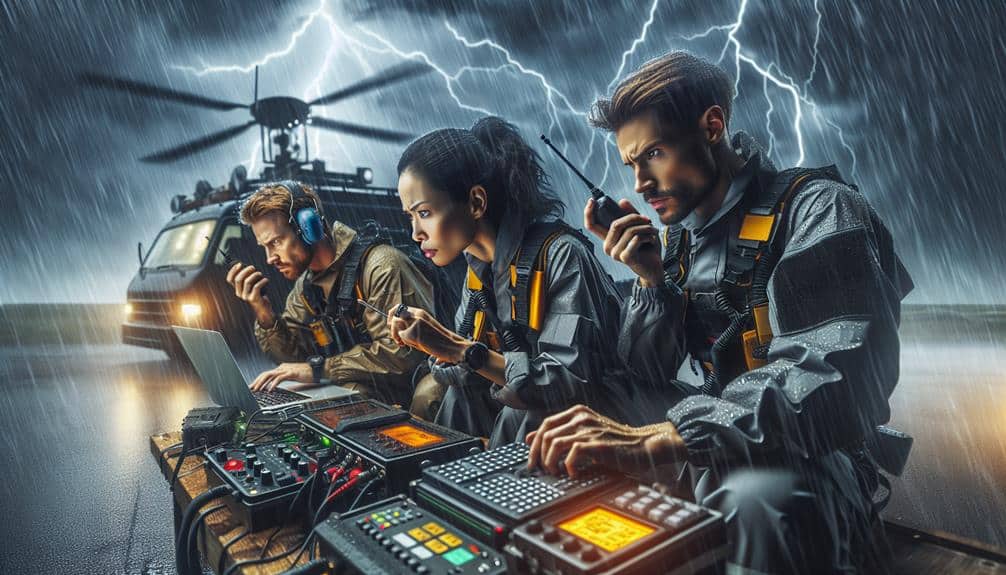During emergencies, we need to assess the situation swiftly and accurately with triage protocols to prioritize care. Clear, direct communication among teams is essential, using standardized terminology. Efficient resource allocation, guided by triage criteria, guarantees patient needs are met. Regular drills and training improve our coordination and decision-making skills. Post-emergency reviews help us analyze our response and identify areas for improvement. Adopting these strategies will enhance our readiness and effectiveness in providing medical assistance during crises. Let's explore how each element contributes to a streamlined emergency response.
Key Points
- Implement structured triage protocols to prioritize patient care based on severity.
- Establish clear, direct communication channels among medical teams for swift information dissemination.
- Regularly conduct simulation drills to refine coordination and decision-making.
- Ensure efficient allocation and distribution of medical resources according to patient urgency.
Assessing the Situation
Our first step in coordinating medical assistance during emergencies is to swiftly and accurately assess the situation. This initial assessment is pivotal, as it sets the foundation for an effective emergency response. By employing well-established triage protocols, we can determine the severity of injuries and prioritize care accordingly. This guarantees that resources are allocated efficiently and those in critical condition receive prompt attention.
During the assessment phase, we gather essential information about the incident's nature, the number of casualties, and the types of injuries sustained. This data allows us to categorize patients based on the urgency of their medical needs. Our triage protocols guide us in making these decisions quickly and confidently, making sure no time is wasted.
Accuracy in this stage can't be overstated. A precise assessment not only saves lives but also prevents the misuse of limited resources. We must stay calm and focused, relying on our training to guide us through the chaos. By rigorously following our triage protocols, we establish a streamlined emergency response that maximizes our capacity to deliver timely and effective medical assistance. This approach empowers us to act decisively, preserving the freedom and lives of those we serve.
Communicating Effectively
Effective communication is crucial to coordinating medical assistance during emergencies. We can't emphasize enough the importance of clear, direct interaction among medical teams. Emergency protocols rely heavily on our ability to disseminate information swiftly and accurately. Our priority is to make sure each team member understands their role and the specific tasks they need to execute.
Team communication must be structured yet flexible. We establish predefined channels, such as radio frequencies or secure messaging apps, to avoid confusion. During high-stress situations, every second counts. Miscommunication can lead to delays, which might cost lives. We stress brevity and clarity in all exchanges.
We've found that regular drills improve our efficiency. By practicing emergency protocols, we fine-tune our communication strategies. These exercises highlight potential pitfalls and allow us to make necessary adjustments before real crises occur.
Moreover, we utilize standardized codes and terminology. This common language reduces ambiguity and makes sure everyone is on the same page. Effective communication doesn't just involve speaking; it also requires active listening. We must listen to feedback from our team to adapt and respond appropriately.
Resource Allocation
Allocating medical resources efficiently during emergencies is crucial to maximizing patient care and outcomes. We need to employ effective triage protocols to prioritize patient needs accurately. By establishing clear criteria for triage, we can make sure that those with the highest urgency receive immediate attention, optimizing the use of our limited medical supplies.
In the heat of an emergency response, having a thorough distribution plan for medical supplies is non-negotiable. We must determine the precise locations where resources are most needed and guarantee a seamless flow of supplies to these critical points. This minimizes delays and prevents bottlenecks that can jeopardize patient care.
Our emergency response teams must be nimble and adaptive, ready to adjust resource allocation strategies based on real-time information. This flexibility allows us to respond to evolving situations with agility, guaranteeing we meet the dynamic needs of the emergency.
Training and Preparedness
Regular training and preparedness exercises are crucial to guarantee our emergency response teams can function effectively under pressure. Through consistent simulation drills and team practices, we confirm that our personnel remain skilled at managing high-stress situations. These practices help us refine our coordination abilities, enhance communication, and streamline decision-making processes.
To achieve peak preparedness, we focus on the following key strategies:
- Thorough Simulation Drills: We replicate real-world emergency scenarios, allowing teams to practice their responses in a controlled, yet realistic setting.
- Multidisciplinary Team Exercises: By conducting drills that involve various medical and support staff, we promote collaboration and improve integrated response efforts.
- Skill-Oriented Training Modules: Regularly updating and practicing essential skills ensures our teams remain proficient in the latest medical techniques and protocols.
- Scenario-Driven Assessments: We evaluate our teams' performance during drills to identify strengths and areas for enhancement, thereby boosting overall readiness.
Post-Emergency Review

After rigorous training and preparedness, we must conduct thorough post-emergency reviews to analyze our response and identify improvement areas. These reviews are essential for capturing lessons learned and pinpointing improvement opportunities that can enhance our future emergency responses.
We begin by gathering data from all involved parties—medical personnel, emergency responders, and affected individuals. This detailed data collection helps us understand what worked well and what didn't. By analyzing this information, we can identify patterns and discrepancies that reveal both strengths and weaknesses in our emergency response strategies.
One key component of the post-emergency review is debriefing sessions. These sessions encourage open dialogue, enabling team members to share their experiences and insights. It's crucial that we foster an environment where everyone feels comfortable discussing mistakes and successes alike. This transparency is crucial for uncovering valuable lessons learned.
Additionally, we should document all findings meticulously. This documentation serves as a reference for future training and preparedness programs, ensuring that identified improvement opportunities are addressed. By committing to continuous improvement, we can enhance our readiness for future emergencies, ultimately safeguarding the health and freedom of those we serve.
Frequently Asked Questions
How Can Volunteers Be Integrated Into Emergency Medical Response Teams?
Let's finesse our approach by ensuring volunteer training. We can enhance team integration through structured orientation programs and role assignments. Properly trained volunteers seamlessly augment our emergency medical response, ensuring efficient and effective aid delivery.
What Are the Legal Considerations During Medical Emergencies?
We must consider legal implications and ethical dilemmas during medical emergencies. Ensuring patient consent, adhering to privacy laws, and balancing resource allocation are critical. Let's act decisively while respecting individual freedoms and legal boundaries.
How Do Cultural Differences Impact Emergency Medical Assistance?
We need to walk a mile in their shoes. Cultural sensitivity and language barriers have a substantial impact on emergency medical assistance. Understanding diverse cultural norms and ensuring clear communication help us deliver effective, respectful, and life-saving care.
What Technology Solutions Can Enhance Emergency Medical Coordination?
We can enhance emergency medical coordination with advanced communication platforms and GPS tracking. Telemedicine and AI assistance guarantee timely interventions and precise patient management, granting us the freedom to deliver effective care promptly.
How to Manage Mental Health Support for Responders During Emergencies?
Imagine a firefighter team as a rock climbers' group; they need each other to ascend safely. We implement peer support and training programs, emphasizing self-care and stress management, ensuring responders maintain their mental health during emergencies.


